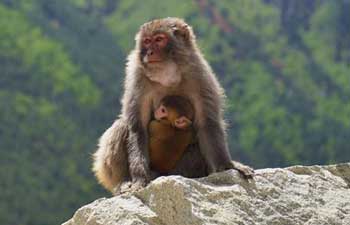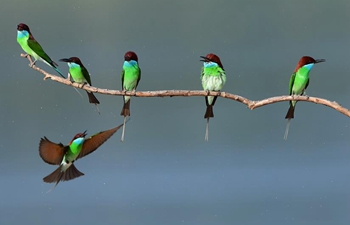 ?
?
Photo taken on May 31, 2018 shows ghost nets during the exhibition "Second Nature" in Athens, Greece. The ghost nets, the deadliest ocean trash and a major environmental threat worldwide, were transformed into 3D printed seashells in an exhibition entitled "Second Nature" held in Athens to raise awareness on marine plastic pollution. It is quite common for fishermen to lose or abandon their fishing nets in the sea -- these are the so-called ghost nets. They remain on the bottom of the sea for years forming dangerous traps for fish and marine mammals. (Xinhua/Marios Lolos)
ATHENS, June 2 (Xinhua) -- The ghost nets, the deadliest ocean trash and a major environmental threat worldwide, were transformed into 3D printed seashells in an exhibition entitled "Second Nature" held in Athens to raise awareness on marine plastic pollution.
It is quite common for fishermen to lose or abandon their fishing nets in the sea -- these are the so-called ghost-nets. They remain on the bottom of the sea for years forming dangerous traps for fish and marine mammals.
The exhibition, organized by the design and research studio New Raw in collaboration with the Aikaterini Laskaridis Foundation, is a very detailed documentation of the full process: from harvesting ghost nets to 3D printed products that are functional and reach art scale, like furniture, chairs, also tableware and products that can be used in everyday life.
For the Rotterdam-based New Raw which develops circularly economy products with recycling materials and 3D printing, it was not easy to turn the ghost nets into a valuable resource.
"We started working with recycled plastics and making furniture for the city of Amsterdam, and we wanted to move this idea further and work with marine plastic waste," Greek architect and founder of the New Raw, Fotini Setaki, told Xinhua in a recent interview.
"Our intention was to 3D print Mediterranean seashells that are regulated or threatened because they are the symbol of cleanness and the beauty of our seas," co-founder of the New Raw, Panos Sakkas added.
Originating from Greece, the design duo wanted also to create a bridge between their new country where they work and the country they grew up.
"We see that the knowledge we have could be applied and we could see a way to do it, because in Greece the marine environment, our coasts, our seas are one of the biggest assets. We said why not bring our agenda and make use of what we learned in the Netherlands and what we are doing there to do something also here," Sakkas said.
The duo started their journey a year ago. They set up a mobile recycling lab in a small touristic area in Greece and could in-situ recycle fishnets and make viable products with it.
Their effort was documented in a short film called "Second Nature" by film-maker Daphne Mantziaraki, which will be presented during Sydney Film Festival 2018.
"Together with Mantziaraki, we wanted to make a short documentary about the people that clean our seas from this waste and about us on how we could turn this waste into treasure," Sakkas explained.
They collaborated with local fishermen and divers that helped recover fishnets from the bottom of the sea and afterwards they recycled the fishnets that took out of the sea.
After being sorted according to their material (nets, ropes, floaters, weights), ghost nets were processed in the grinder and extruded to produce colorful and textured filaments for 3D-printing.
The result was digitally crafted seashells, with an altered geometry.
The duo prove that design and technology can be used against marine plastic pollution, leading to a zero-waste future.
"Our vision is a zero-waste future starting with plastic and starting with all the plastic is in our seas or is in our environment," Sakkas said.
Through the exhibition, that runs until June 10, they want to show that marine plastic is the raw material for a new economy, that uses technological and cultural innovation to bring about social change.
"What we want to communicate is that the waste is a resource and we should stop thinking in a linear process and think more circular. All materials could be reused for recycling," Setaki told Xinhua.
"At the same time, we want to show that sometimes problems can stimulate new ideas and help us think of new solutions that bring up innovation and creativity," she stressed.
During the exhibition, the Laskaridis Foundation organized educational programs for school students who had the opportunity to learn about the marine pollution caused by the ghost nets and their transformation to thread for 3D printers.
"We have to build in the future. Regarding the education sector, it is important to bring technology and environmental issues together, not only to inform but also to move forward to the next step and show what can be done," Elia Nikitopoulou, communication manager of the Laskaridis foundation said.















